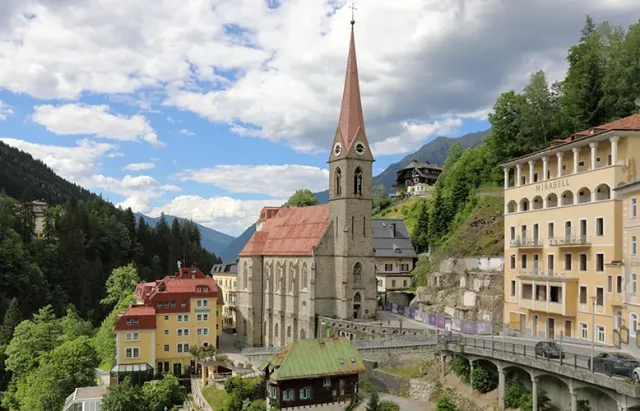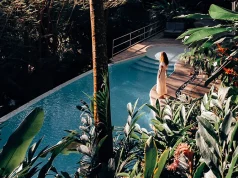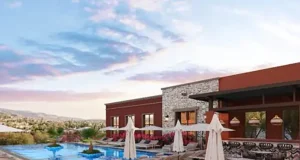
At the end of a narrow Alpine valley, surrounded by forested slopes and waterfalls, stands Bad Gastein. Its grand hotels cling to the cliffs like relics from another century, their façades softened by mist and time. The sound of falling water fills every corner of the gorge.
Once, Bad Gastein was one of Europe’s most fashionable destinations, a place where emperors, writers, and scientists came to take the waters, breathe the mountain air, and watch the world unfold from marble terraces. Then the century turned, the guests left, and silence settled in. For decades, it lingered, half-forgotten, half-preserved.
Now the town is stirring again.
The Shape of a Town in Decline
Few places in Austria tell their story so visibly. Bad Gastein’s streets climb steeply from the valley floor, winding past Belle Époque hotels and sanatoriums that once promised vitality and cure. The buildings stand close together, their tall, narrow profiles following the cliff face in a kind of architectural cascade.
In the early morning, fog rises from the Gasteiner Ache, a river that tumbles straight through the center of town. It is not a gentle stream but a force, roaring past old bridges and spa arcades, scattering light through the mist.
Many of the grand hotels still bear their names in fading gold letters: the Straubinger, the Badeschloss, the Grand de l’Europe. Their windows once glowed with candlelight and music. Some are being restored, others still waiting, caught between two centuries.
This in-between state gives Bad Gastein its character. It is neither ruin nor revival but a place in conversation with its own past.
The Water and the Mountain
The town’s existence has always depended on its water. Hot springs rich in radon rise from deep inside the mountain, a geological phenomenon that once drew Europe’s elite. Patients would descend into vaporous tunnels carved through the rock, their treatments combining science and ritual.
Today the radon galleries remain open, and visitors still come to bathe, but the mood is different. The spa culture has softened from cure to calm, from prescription to pleasure. The focus has shifted from what the water promises to how the landscape feels, the balance of steam, air, and altitude.
Above town, cable cars climb toward the Hohe Tauern peaks. The view opens wide over ridges and forests, the faint shimmer of snow always visible. You understand why people returned here again and again. It is not the therapy but the rhythm, the mountain’s slow, endless breathing.
A New Kind of Energy
In recent years artists, designers, and young Austrians have rediscovered Bad Gastein, drawn not by nostalgia but by atmosphere. The abandoned hotels have become studios, pop-up galleries, and stages for summer festivals. Music drifts from balconies and light installations fill old halls where guests once danced in evening dress.
The tension between decay and beauty gives the town a strange electricity. It feels alive precisely because it is imperfect. You walk past a crumbling archway and glimpse a new café or a record store inside. The revival is quiet, improvised, and sincere.
This new generation treats the place not as a resort but as a setting, a stage for slow living, conversation, and reflection.
Many bike tours in Austria now include detours through the Gastein Valley, following mountain roads that wind between waterfalls and pine forests. Cyclists stop in Bad Gastein not for luxury but for atmosphere, for the echo of history, the scent of rain and resin, and the sound of the waterfall at dusk.
The road into town curves steadily upward. Each turn brings another glimpse of peaks, another rush of water. By the time you reach the center, the town feels suspended between mountain and mist, between what it was and what it might become.
The People Who Stayed
Even in its quietest decades, Bad Gastein was never truly empty. Families who had run hotels for generations stayed on, tending to buildings they could not quite abandon. Bakers, postmen, and innkeepers kept daily life moving beneath the grandeur.
One local café still serves pastries baked from recipes unchanged since the 1920s. The owner, now in her seventies, says she can tell the season by the sound of footsteps outside: skiers in winter, hikers in summer, artists in between. “The town sleeps,” she says, “but it dreams all the time.”
Her words fit the place perfectly. There is a dreamlike quality to Bad Gastein, a sense that it exists slightly outside time, waiting for something, or perhaps content to wait forever.
Between Water and Light
The heart of Bad Gastein is its waterfall. It drops through the center of the town, carving a vertical line of movement that no photograph ever captures. In the early evening, when the sun slips behind the peaks, the water glows like liquid glass. Mist drifts through the streets, touching balconies and lampposts, turning the air almost tangible.
People pause on bridges to watch. Some take photos; others simply stand and breathe. The scene feels both monumental and intimate, a reminder that the town was always built around this sound, this endless movement.
At night, the waterfall is lit from below, and the old hotels appear like sentinels. The combination of ruin, beauty, and sound creates something close to theatre. You half expect the windows to open and the past to step outside.
The Future in Stillness
Bad Gastein’s revival is not a reinvention. It is a quiet reawakening, an understanding that its imperfections are part of its soul. The town no longer tries to be grand; it has learned to be authentic.
Visitors come less for therapy than for atmosphere, less for luxury than for light. They swim in the thermal pools, walk through the forests, and sit on balconies that overlook both the valley and history.
And slowly, the town is learning to live again. The hotels reopen one by one. The artists return each summer. The waterfall keeps falling.
Bad Gastein’s greatest strength may be that it has nothing left to prove. It does not sell you a story. It lets you feel one.





